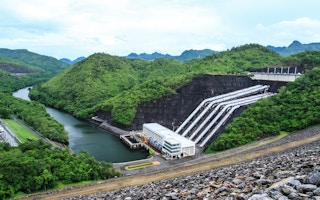Hydroelectric power remains the most attractive renewable energy investment in the Philippines as eight new mini hydro projects gain approval for construction this year.
To continue reading, subscribe to Eco‑Business.
There's something for everyone. We offer a range of subscription plans.
- Access our stories and receive our Insights Weekly newsletter with the free EB Member plan.
- Unlock unlimited access to our content and archive with EB Circle.
- Publish your content with EB Premium.
Hydrotec Renewables, the developer of the eight projects, which champions the use of low-impact hydropower construction said this week the company is investing US$53 million to US$62 million on the combined 25-30-MW projects, eyed for completion by 2016.
The projects are located in nearby provinces outside Metro Manila, with three in Rodriguez City (Sitio Wawa, San Isidro and San Jose), one in San Mateo, two in Marikina City (Tumana and Nangka 4) and two in Antipolo City (Hinulugang Taktak and Nangka 1).
The company applies a ‘sustainable small hydro approach’, where it incorporates data gathered from hydrological, topological and metrological research in the construction process, including project site attributes to avoid the need to cut trees and inflict environmental disruption to the flora and fauna and existing communities, its website said.
The company also espouses turnkey installation that do not require ‘tunnelling’ or capital intensive building, thus shortening the construction timeframe to only seven to nine months.
The eight new projects will also be installed with real time, satellite-connected weather forecast system at each of Hydrotec’s hydropower plants at no cost for the hosting local city or municipal government.
This aims to improve the efficiency and operation of the plant by giving a precise 72-hour forecast about any meteorological events like storms, typhoons, direction and speed of wind and clouds, and amount of rainfall. Trash racks will also be installed to help remove waste and garbage materials from the rivers.
The company, owned by Filipino and German investors, said it is also looking to install power plants in Leyte and other areas devastated by super typhoon Haiyan last November.
The typhoon had put tremendous pressure on the nation’s power grid after causing major damages to energy facilities in the affected areas. Thus, renewable energy plays an important role in the reconstruction of these communities.
The country is already one of the world’s leaders in renewable energy, with a third of its primary energy source coming from renewables. Its Climate Change Commission said last year it is laying a sustainable energy roadmap which aims to shift the country’s current fuel system to 100-percent renewable energy capacity in a decade.
“Any kind of renewable, ecological friendly produced electricity is an essential contribution to the protection of our environment and nature for forthcoming generations and it will stabilise or lower electricity prices,” Hydrotec Renewables managing director Hannes Mueller said in a statement.
According to Department of Energy (DOE) data, hydropower - with a total capacity of 5,468MW - will contribute the most amount of renewable energy in the country. Out of this, 2,950MW are still in the pipeline.
“The major benefit of our projects is the average annual contribution of hundreds of megawatt-hours of clean electricity to the Philippine grid, reduction of brownouts, avoiding thousands of tonnes of carbon dioxide emissions and a significant reduction of the import and dependence of crude oil and the operation of environment polluting carbon and diesel plants,” Mueller added.
Wind breaks
Separately, four wind energy projects in Luzon were awarded the certificates of commerciality last month which means developers can proceed with the construction of the projects and that upon operations, these projects would supply to the grid under the feed-in-tariff (FIT) system.
“
Any kind of renewable, ecological friendly produced electricity is an essential contribution to the protection of our environment and nature for forthcoming generations and it will stabilise or lower electricity prices.
Hannes Mueller, managing director for Hydrotec Renewables
The government has approved FIT rates for renewable energy last year for wind, solar, hydroelectric and biomass energy at a rate lower than those asked for by renewable energy developers.
The FIT per kilowatt hour for solar power is set at PhP9.68 (US$0.223); wind, PhP8.53 (US$0.197); run-of-river hydroelectric power, PhP5.90 (US$0.136) and biomass PhP6.63 (US$0.153). Under the system, electricity sold to consumers is fixed for a period of 20 years.
The projects are: Energy Logics Philippines for a 48MW in the municipality of Pasuquin; Energy Development Corp’s 63MW expansion of its existing project in the municipality of Burgos; AC energy Holdings’s 45MW in Pagudpud; Ilocos Norte through its joint venture with Northern Luzon UPC Asia Corp, and an 18MW expansion of its 33MW wind farm in Bangui.
These projects will add to five other ongoing constructions that have already received the ‘declarations of commerciality’ from the government.
Wind power is third among proposed renewable energy projects in the country after hydroelectric and geothermal, aiming to supply 417MW to the grid.The 33MW Bangui Bay Wind Power Project in Ilocos Norte is so far the only wind project that is supplying the grid.
The DOE further announced last month that in 2014, some 633.5MW of electricity coming from wind and solar projects will be added to the grid and can power 126,700 households. Director of the DOE’s renewable energy management bureau, Mario Marasigan said in a forum last year that renewable energy contributes between 38 to 39 per cent to the country’s overall primary energy resources.
Geothermal and hydropower plants each account for about 14 per cent of the country’s total energy mix, while other renewable sources such as wind, solar and biomass are still comparatively undeveloped. The country is aiming for its overall renewable energy programmes to have a capacity of 15,304 MW by 2030, up from about 5440 MW currently.








